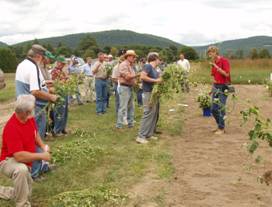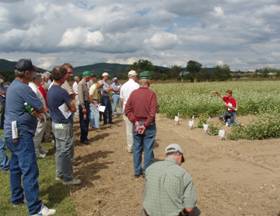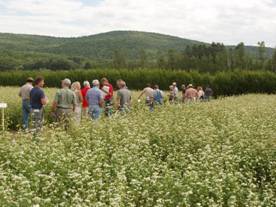Northeast Buckwheat Growers Newsletter
No. 20 September 2005
Edited by Thomas Bjorkman, Cornell NYSAES, Geneva NY
- 2005 Field Day in the Twin Tiers
- Heat blasting and drought
- Following a spring crop with buckwheat
- Ernst Conservation Seed
- No-till buckwheat
- Light kernels not so bad in Koto
- Swathing equipment
2005 Field Day in Twin Tiers
The eleventh annual Northeast Buckwheat Field Day was August 23, 2005 in the Southern Tier of NY. It drew growers from northern Pennsylvania as well as central and western New York. The attendance was about 40 people. The host location was the Big Flats Plant Materials Center courtesy of its director, Martin Vandergrinten. 
The Big Flats Plant Materials Center, part of the USDA Natural Resources Conservation Service, selects new conservation plants and develops new plant technology to provide vegetative solutions to conservation problems in the Northeast region. The Center has developed new technology for improving forage, buffer strips, cover crops, watershed protection, mine reclamation, living snow fences and windbreaks. Many of the growers at the field day had applications for conservation plantings on their farms. The specialized seed cleaning equipment was a strong draw for those who appreciate clever machinery.

The field demonstrations included the effects of planting methods. The field was sown June 29, so seed fill was well along. There had been a heavy rain soon after sowing that reduced the stand. This is a silt loam--many marveled at the lack of rocks--that has good drainage but can have slow infiltration. The 50 lb/ac (120 seeds/m2) seeding had a stand of about 55/m2. The double seeding rate was only slightly higher at 70/m2. Normal populations are 100-120. There were three seeding depths, 1/2, 1, and 2 inches. The deepest planting took longer to emerge, and there was a little pigweed in the stand as a result. The recommended rate of 50 lb/ac and seeding depth of 1 inch worked well.
There were four breeding lines on display that have potential for use as cover crops. The first four internodes are only about an inch long, and the lower leaves are extra large. The idea is to increase their ability to smother weed seedlings. When in flower, these plants had an unfamiliar look. They were bushy down low, with spikes of seed stalks coming up above the low canopy. This is a concept worth testing further as more seed becomes available from Dr. Campbell's program.
Deer eat buckwheat to the point where it is grown by some specifically as wildlife fodder. It was a surprise to see buckwheat untouched immediately adjacent to some rows of heavily grazed soybeans. Someone suggested planting soybean guard strips!
Heat blasting and drought
After two wet and very difficult buckwheat seasons, we had a very different season in 2005. In many areas, planting conditions were very favorable and the crops got off to a good start. However, rainfall in June was very patchy and some growers planted into very dry soil, hoping that rain would come soon. For some, it didn't. In those cases, emergence was slow and spread out. Harvest will be challenging if it is late and non-uniform. Swathing can help save the early seeds while giving the later ones a chance to mature, it will also protect the crop from frost.
Drought increases the tendency of buckwheat leaves to wilt in the afternoon. A little afternoon wilting doesn't reduce growth much because the leaves are just trying to get out of the sun a little. However, it lets light through to the ground, which can let weeds grow. If you are raising buckwheat as part of a weed control program, this is problematic.
Many areas set records for heat, especially days over 90 degrees. Buckwheat flowers are more prone to abort at temperatures over about 86 degrees. They are in the most sensitive stage 30-40 days after seeding (or, for those with very dry ground, 30-40 days after they finally germinate). For July 4 seedings, the most sensitive period would be August 4-14. Geneva exceeded 86 degrees on 6 of those 10 days, but there were cooler periods both before and after. Buckwheat from July 5 at Cornell's Geneva campus did suffer some heat blasting. Growers in cooler sites, particularly at higher elevations, could expect less damage. Growers who delayed planting until mid-July should also have minimal heat injury, but will be hoping for frost to hold off until mid-October.
Previous research by the Björkman group at Cornell has shown that late flowers don't make seeds, even if the early seeds are lost. Therefore, the plants are unlikely to make up for flowers and seeds that aborted due to high temperatures.
Growers who received timely rains, even if they weren't abundant, are reporting attractive stands. This is the kind of year when heavy ground does well because it holds moisture. We should see some encouraging yields from the favored spots.
Following a spring crop with buckwheat
Research in 2005 investigated land preparation for buckwheat following peas. This rotation has long been used to hold the ground for a fall grain crop and to prevent weeds. It is also used for early beans, spinach or lettuce. The fastest and cheapest way to do so is no-till planting soon after harvest. For us, no-till was unsuccessful. The ground was too dry and hard for vigorous buckwheat growth, so the weeds that had established in the peas soon overwhelmed the buckwheat.
It is standard practice to incorporate pea or bean residue so that disease organisms are killed by soil microbes. We wondered whether it was necessary to wait for the peas to decompose before sowing buckwheat. The recommended wait between incorporating crop residue and sowing, usually 10-14 days, is meant to avoid the nitrogen tie-up that occurs during the early stages of degradation. In spring, there is also concern about attracting seed maggots. But soil nitrogen is abundant after peas or beans, the soil is warm enough that the small amount of residue should not tie much up, and buckwheat doesn't need much nitrogen in the first place.
It turned out that sowing immediately after incorporation didn't work well. The stand was reduced by half, although the plants grew well once established. However, for a cheap weed-controlling cover crop, it won't do to have half a stand or to need twice the seed. Waiting one or two weeks gave normal stands. But by two weeks, there was enough weed growth that there were significant escapes. The most common was redroot pigweed, which is probably the most common weed in buckwheat stands . The conclusion is that you don't have to wait the full 10-14 days after incorporating, but you can't sow right away either.
Ernst Conservation seed
The Ernst family, of Meadville PA, has been producing specialty seeds for three generations. Buckwheat has been a part of that since the beginning. Not only is buckwheat seed a good product, but it is very helpful in rotations for producing certified seed of other crops.
For producers of Certified seed, absence of weed seed is a big issue. Raising buckwheat before the seed crop is very helpful. They do that on their own land and encourage the growers who supply them to do so as well.
The Ernst company sells buckwheat seed for wildlife and cover crops. It is not sold as certified seed, but is the progeny of Certified 'Mancan.' Mancan was released by Agriculture Canada in 1972 and introduced to the Northeast soon thereafter. It was largely superceded by 'Manor' in the 1980s for milling purposes. Calvin Ernst likes how Mancan performs as a cover crop and that consistent genetic stocks are available. Before going to a named variety with superior milling qualities in the 70's, they raised a Silverhull type called Crawford County common. The local common buckwheat had been the top performer in their company variety trials every year. It is no longer available. They currently have agreements covering about 250 acres with 10 local growers. Should interest in buckwheat for wildlife plots and cover crops increase, they have the capacity to increase production.
No-till buckwheat
Terry Bistrovich is pleased with his buckwheat crop on no-till ground. He has a no-till farming operation on Tug Hill near the Adirondack mountains, and he felt that buckwheat would be a good complement in his rotation. He no-tilled into corn stubble and into killed former hay on June 26th after killing the weeds with Roundup. The soil was in good shape for planting. The no-till drill cut the residue well, the seed furrows closed completely, and there was moisture in the ground that reached the seeds well. The seedlings were well established after a week, and at this writing the crop estimate is far above average.
No-till planting was also discussed at the field day. Carl Albers of CCE in Steuben Co suggested that even before no-till seeding, it's worth giving the herbicide time to work. Waiting 3-7 days before tilling is common in order to allow time for enough herbicide to be translocated to the roots before tilling disturbs the plant. No-till leaves most weeds undisturbed, so it is tempting to cut the time between herbicide application and planting. Professor Russ Hahn at Cornell estimates that one day is long enough to wait between Roundup application and no-till seeding to kill perennial weeds, but annuals absorb a lethal dose in as little as an hour.
Light kernels not so bad in Koto
After 2 years experience with Koto, Larry Strickland reports a big reduction in light kernels. Manor produces a substantial amount of partially filled kernels. Manisoba was an improvement, and Koto is significantly better. The completely empty ones are blown out by the combine, but often there are some that are not filled enough for milling that are blown out in the seed cleaner. Those kernels don't weigh that much, but they can take up a lot of space in the truck. It is always disappointing to have a truckload turn out to have a lower paid weight than you anticipate. With Koto that is happening less.
Swathing equipment
A number of growers interested in swathing their buckwheat have not done so because the equipment is not readily available on the local market. There are many lightly-used swathers and pickup heads available in the plains states, but transportation cost and time have discouraged action. Pete Gianforte of Cazenovia, NY bought this equipment a few years ago through his John Deere dealer. The swather and pickup head were used equipment from North Dakota. The local dealer arranged transportation that was reasonably priced. The equipment was in excellent condition, exactly as advertised. The dealer route may be a more economical option than many have thought.
